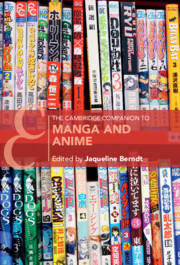Book contents
- The Cambridge Companion to Manga and Anime
- The Cambridge Companion to Manga and Anime
- Copyright page
- Contents
- Figures
- Contributors
- Acknowledgments
- Notes on Japanese Names, Terms, and Titles
- Chronology
- Introduction
- Part I Claimed Origins and Overlooked Traditions
- Part II Drawing and Movement
- Part III Sound
- Part IV Narrative
- Part V Characters
- 10 Characters in the Media Mix
- 11 Character Acting in Anime
- Part VI Genres
- Part VII Forms of Production
- Part VIII Forms of Distribution
- Part IX Forms of Use
- Further Reading
- Index
- Cambridge Companions to Literature
10 - Characters in the Media Mix
Beyond Narratives
from Part V - Characters
Published online by Cambridge University Press: 07 November 2024
- The Cambridge Companion to Manga and Anime
- The Cambridge Companion to Manga and Anime
- Copyright page
- Contents
- Figures
- Contributors
- Acknowledgments
- Notes on Japanese Names, Terms, and Titles
- Chronology
- Introduction
- Part I Claimed Origins and Overlooked Traditions
- Part II Drawing and Movement
- Part III Sound
- Part IV Narrative
- Part V Characters
- 10 Characters in the Media Mix
- 11 Character Acting in Anime
- Part VI Genres
- Part VII Forms of Production
- Part VIII Forms of Distribution
- Part IX Forms of Use
- Further Reading
- Index
- Cambridge Companions to Literature
Summary
Within the last two decades, the specialized term “chara” has gained recognition for denoting fictional beings that seem typical for Japanese popular media. Usually, a distinction is made that charas – distinguished from “characters” – are somehow independent of the narrative. Since the term emerged in a variety of different discourses, however, it serves many contradictory functions. This chapter maps different ways to conceptualize the protagonists of Japanese popular culture as charas with regard to the popular franchise Demon Slayer (Kimetsu no Yaiba). It introduces four relevant oppositions: “consequentiality versus cartoonishness,” “representational realism versus ludic realism,” “narrative consumption versus database consumption,” and “authorized works versus secondary productions.” What connects all these vastly different meanings of charas and the respective “other sides of narrative” is a shared interest in characters not as parts of closed, fictional stories or worlds but as nodal points of historically changing media practices and conventionalized modes of imagination and participation.
Keywords
- Type
- Chapter
- Information
- The Cambridge Companion to Manga and Anime , pp. 135 - 145Publisher: Cambridge University PressPrint publication year: 2024

